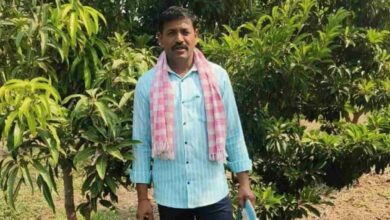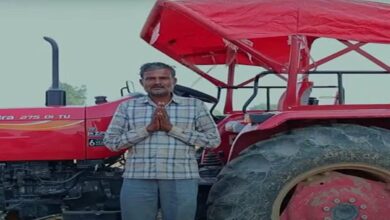Success Story: This Assam farmer earned a huge profit of Rs 2.5-3 lakh from rice, maize and fish farming
Success Story: Boka village in Sonitpur, Assam, is home to 39-year-old farmer Lakhyadhar Das, whose life has taken unexpected twists. He was formerly a businessman who traveled a lot for work, but after losing his wife in 2019, his life took a significant turn. He was having more and more trouble keeping his company viable as he tried to juggle it with the demands of parenting his two young boys by himself. In 2021, Lakhyadhar went into farming as a means of generating a steady income that would enable him to be near his children.

He progressively turned his attention to agriculture, owning three bighas of land and leasing another seventeen. He started cultivating a range of crops with meticulous preparation, guaranteeing a consistent income all year long to sustain his family.
Cultivation of Rice and Market Demand
The primary crop of Lakhyadhar Das is rice. He grows three varieties of rice: Aizome, Joha, and Bara. Bara rice is a significant seasonal crop that is especially sought for during Assam’s Bihu festival. Bihu, a vibrant agricultural celebration, is when demand for this rice soars. There are three main types of Bihu, each of which honors a different phase of the agricultural cycle: Magh Bihu (also called Bhogali Bihu), Kati Bihu, and Bohag Bihu (also called Rongali Bihu).
Because of its unique scent, Joha rice is highly valued in the market, selling for Rs 10,000 a quintal or Rs 1,000–1,100 every mun (40 kg). Another high-value crop that makes up a significant portion of his revenue is Aizon rice.
Approximately 190 tons (7,600 kg) of these rice cultivars are produced by him each year. He follows a defined timetable for his agricultural activities, planting paddy in May and harvesting it in October or November. Ten days after harvest, the rice is dried and prepared for sale, guaranteeing a rapid market turnover and minimal storage expenses.
Expanding into Different Crops
On two bighas of land, Lakhyadhar Das plants maize in addition to rice. As an additional source of income, he cultivates potatoes on two or three bighas. Malbhog bananas, a popular kind in Assam, are grown on his estate. Because different crops are produced and sold at different periods of the year, this diversity allows him to maintain financial security.
He visited a dragon fruit orchard on a bigha of land last year. Due to its great market demand and health benefits, the high-value crop is also well-liked. Even though dragon fruit farming is still in its infancy, he is optimistic that it will turn out to be a profitable endeavor for his farm company.
Wildlife-Related Challenges
The biggest problem for Lakhyadhar Das is that wild elephants often invade his property. Each year, when the rice is ready to be harvested, his field and the surrounding region are severely damaged by massive herds of elephants, sometimes totaling over 200. Despite many instances, there is little official support or action to prevent such intrusions.
He suffers enormous losses as a result of this ongoing issue. Particularly when many harvest bighas are destroyed and crushed in a single night. He is now investigating ways to protect his farms. For instance, he is using various fences and growing guard plants, and he is requesting that the government help them deal with this issue. However, this is a significant obstacle that affects many other farmers nationwide in addition to him.
Plans for the Future and Fisheries
Beyond cultivating crops, Lakhyadhar Das has a strong interest in fishing. He raises a variety of fish species, including Rohu, Bahu, Sikal, and Common Carp, in his one-bigha pond. Every year, he earns an additional Rs. 50,000 to Rs. 60,000 from his fishing business.
However, his ambition for this business is much broader. The dwindling numbers of some fish in Assam are of special concern to him. His goal is to breed these endangered fish under controlled settings in order to save them. He is certain that he can both maintain and export these species to outside markets using the appropriate breeding and conservation techniques.
According to him, these fish are highly sought-after in international markets and command competitive rates. By doing this, he hopes to increase his revenue and contribute to the preservation of Assam’s aquatic biodiversity.
Dream of Mechanization and Growth
Lakhyadhar Das has lofty goals for the future as well. He intends to buy at least 25 more bighas of land for rice cultivation in order to expand his agricultural enterprise. He believes there is a lot of market potential for the high-value Joha and Aizome rice types, and increasing output will allow him to make more money.
With an annual profit of Rs. 2.5-3 lakh, he intends to expand his operations by purchasing a tractor, which would significantly improve his agricultural productivity. Tractors will help to speed up land preparation and reduce labor expenditures. Currently, he employs time-consuming and labor-intensive traditional approaches. With a tractor, he will be able to more effectively farm additional land and increase his total production.
A Note to Other Farmers
The story of Lakhyadhar Das serves as a live example of the power of adaptability and resiliency. He overcame financial difficulties and emotional grief by turning to agriculture as a means of rebuilding his life. It proves that agriculture can be a reliable and profitable source of revenue when done strategically and diversified.
He advises other farmers to focus on high-value agricultural goods, diversify their crops, and use contemporary farming practices. He asserts that farmers must explore other possibilities, such as fruit growing, conservation, and fisheries, since they cannot continue using traditional ways. He also emphasizes the need for independence since governments often provide little assistance.
Lakhyadhar Das’s tenacity and innovative thinking have transformed his life and made him an inspiration to others in the agricultural community. His goals to expand his farm, save endangered fish species, and export high-quality products are a clear illustration of how farming can be both lucrative and sustainable with the right approach.





